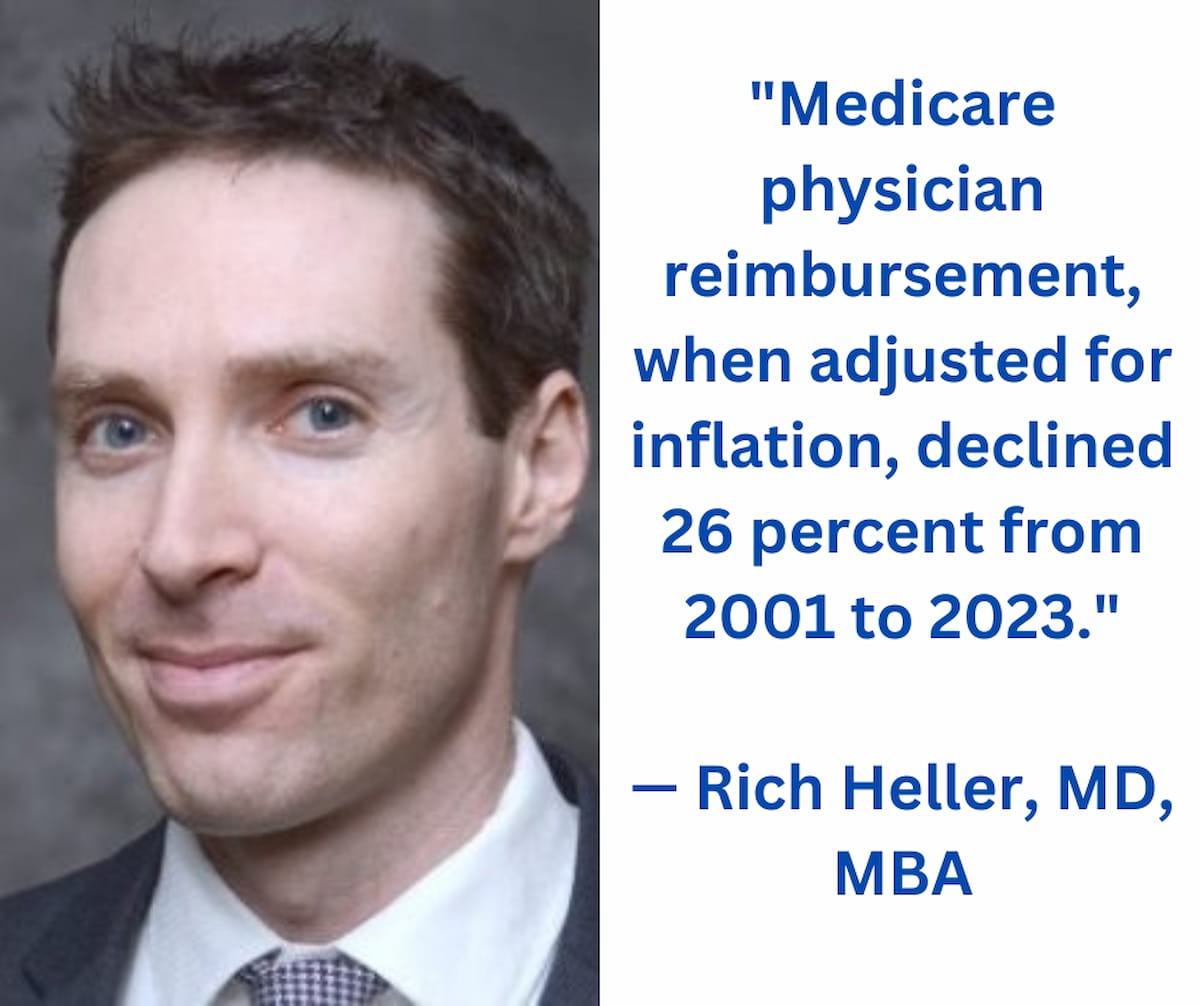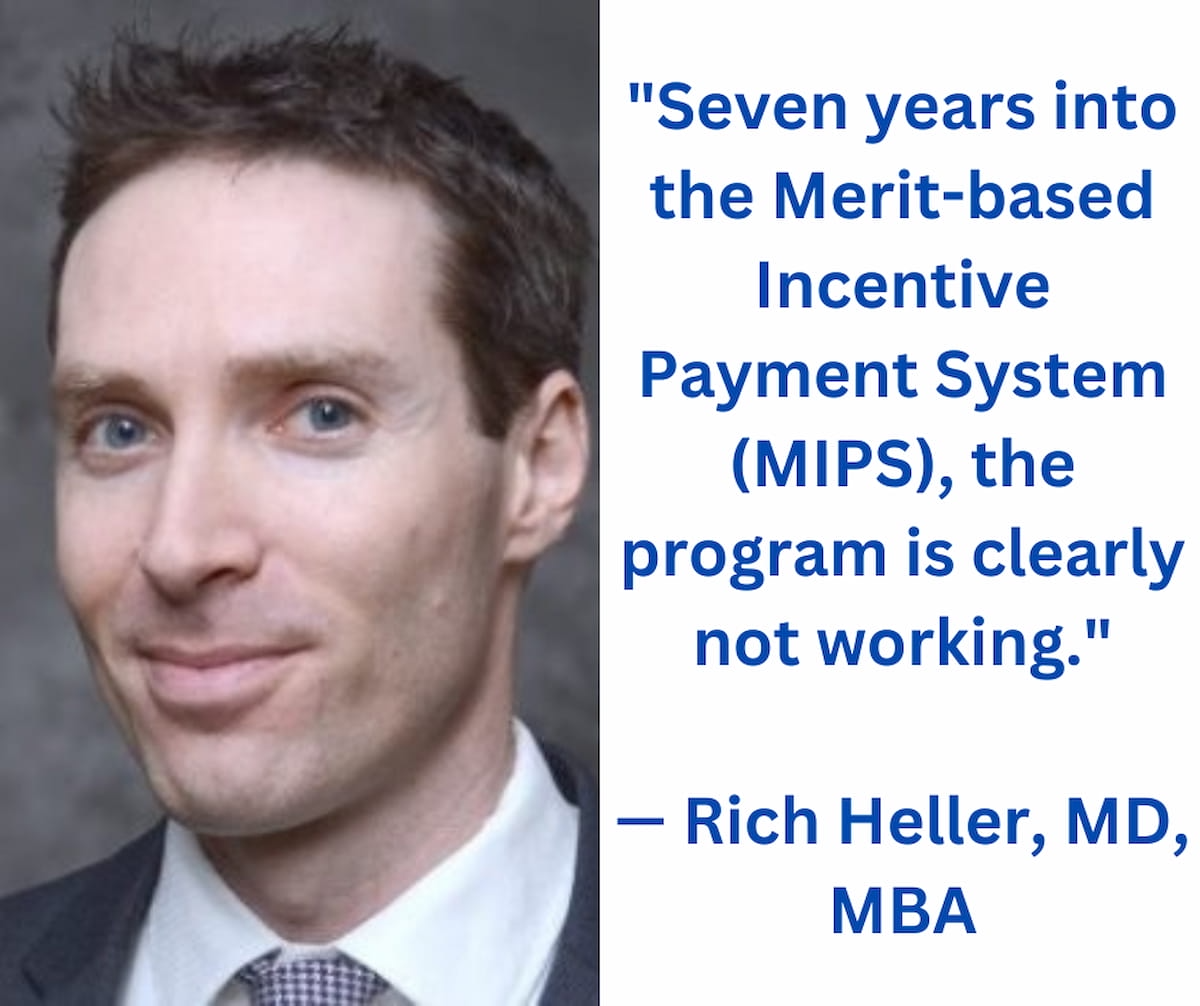Stabilizing Medicare Reimbursement: A Plan For Action
Noting that the Medicare conversion factor in 2024 could be lower than the rate in 1993, this author discusses three key issues that need to be addressed by government leaders in order to ensure equitable Medicare reimbursement for radiologists and other physicians.
President Joe Biden is fond of saying “Don’t tell me what you value. Show me your budget, and I’ll tell you what you value,” a quote he attributes to his father.1 Political rhetoric is one thing, but actions speak louder than words. Both President Biden and House Speaker Kevin McCarthy talk about protecting Medicare, but do their actions match their words?2,3
The Medicare conversion factor, the rate that Medicare uses to pay health care providers, is lower in 2023 than it was a quarter century ago in 1998. On July 13, the Centers for Medicare and Medicaid Services (CMS) released its proposed Medicare conversion factor for 2024.4 In the face of inflation, a workforce shortage and widespread burnout, CMS further reduced the rate by over 3 percent. The last time the rate was lower was in 1993. For context, that is before Friends premiered on TV, before Tom Brady threw his first NFL pass, and five years before Google was founded. Blockbuster Video was popular, and Justin Bieber hadn’t yet been born.
Radiology has been especially affected by Medicare cuts. Annually, CMS publishes an “impact table” which details how changes in Medicare reimbursement policy impact each health care specialty. Since 2010, the predicted impacts to radiology reimbursement from the Medicare policy changes have ranged between 0 percent and -10 percent. The predicted impact to radiology in the 2024 proposed rule is -3 percent. A study showed that between 2007 and 2019, there were inflation-adjusted reductions in Medicare reimbursement across all imaging modalities.5 Given the central nature of radiology in screening, diagnosis and disease management, along with a shortage of radiologists, these cuts threaten care to Medicare beneficiaries.
There are numerous problems with the Medicare fee schedule. Here are three issues that Congress and the President should address.
Conversion factor stability. The American Medical Association (AMA) calculated that Medicare physician reimbursement, when adjusted for inflation, declined 26 percent from 2001 to 2023.6 In 2023, hospitals, ambulatory surgical centers and other types of facilities received a boost in Medicare payment, at least partially offsetting inflation.7 This boost did not apply to physicians. Despite inflation raising staff salaries, rent and equipment costs, the provider reimbursement rate was cut. With decreasing Medicare reimbursement as well as increased pressure from commercial health insurers, medical practices must look to make cuts somewhere and it’s naïve to think that Medicare beneficiaries will not be impacted.
The March 2023 Medicare Payment Advisory Commission (MedPAC) report to Congress acknowledged these concerns and recommended Congress increase 2024 pay rates to offset inflation.8 MedPAC recommended an increase of 50 percent of medical inflation, which the AMA noted was helpful but insufficient.9 A bipartisan bill linking Medicare pay rates to inflation has been introduced in Congress and would greatly help stabilize the system.10

2) Budget neutrality requirement. Part of the problem with Medicare payment policy is mandatory budget neutrality. As a result of budget neutrality, CMS is constrained in its policy-making such that support for one area necessitates cutting another. This “robbing Peter to pay Paul” approach comes with unintended consequences.
For example, interventional radiology (IR) received the greatest cut in the 2024 proposed rule. The unintended consequence of support for other areas of medicine is a cut to IR. Since IR procedures are often more cost-effective than alternative therapies, disincentivizing their use through reductions in reimbursement is counterproductive, potentially making care more expensive while limiting patients’ access to minimally invasive procedures that may reduce morbidity and mortality.11-13 The threat of losing access to IR is especially worrisome for patients in rural communities.14 While budget neutrality requirements were well-intentioned, the AMA and others have noted these requirements should be revised.15

3) MIPS. In 2015, Congress passed the Medicare Access and CHIP Reauthorization Act (MACRA), a law establishing the Quality Payment Program and its Merit-based Incentive Payment System (MIPS). The goal of MIPS is straightforward and laudable: link Medicare fee-for-service payments to performance to improve the value of care delivered to Medicare beneficiaries. Seven years into MIPS, the program is clearly not working.
At a June 2023 House Energy and Commerce Oversight and Investigations Subcommittee hearing on MACRA, MIPS was described as a failure that is burdensome to providers, unhelpful to patients, and costly to the United States health-care system.16 Due to a lack of relevant measures, an almost total absence of measures that are uncapped in point value and an increasing performance threshold, it is possible for a radiology practice to perform exceptionally well, and still be penalized in MIPS for “underperformance.”
At the House subcommittee hearing, it was suggested that MIPS be scrapped entirely. This was not a new suggestion. In 2018, MedPAC wrote that the “burden of MIPS will outweigh its value to Medicare beneficiaries, the Medicare program, and clinicians” and “should be eliminated.”17 At the least, Congress should intervene immediately to pause the program while CMS addresses fundamental problems with MIPS.
Final Notes
President Biden’s father was correct. Your budget speaks louder than your words. It is inexcusable that the Medicare conversion factor in 2024 could be lower than the rate in 1993. At a time when medical practices are struggling with inflation, a workforce shortage, burnout, and a burdensome MIPS program, inaction sends a message about how health-care workers and patients are valued. Congress and the President have an opportunity to demonstrate that they sincerely value physicians and the Medicare patients in their care. Let’s hope they take this opportunity.
Dr. Heller is the associate chief medical officer of communications and health policy, and the national director of pediatric radiology at Radiology Partners.
References
1. White House. Remarks by President Biden announcing the fiscal year 2023 budget. Available at:https://www.whitehouse.gov/briefing-room/speeches-remarks/2022/03/28/remarks-by-president-biden-announcing-the-fiscal-year-2023-budget/#:~:text=He%20said%2C%20%E2%80%9CDon't,that%20we%20%E2%80%94%20what%20we%20value . Published March 28, 2022. Accessed July 24, 2023.
2. White House. Remarks by President Biden on social security and Medicare. Available at: https://www.whitehouse.gov/briefing-room/speeches-remarks/2023/02/09/remarks-by-president-biden-on-social-security-and-medicare/ . Published February 9, 2023. Accessed July 24, 2023.
3. Konish L. Social security, Medicare should be ‘off the table’ in debt ceiling talks, McCarthy says. CNBC. Available at: https://www.cnbc.com/2023/01/30/social-security-medicare-off-table-in-debt-ceiling-talks-mccarthy.html . Published January 30, 2023. Accessed July 24, 2023.
4. CMS. Calendar year (CY) 2024 Medicare physician fee schedule proposed rule. https://www.cms.gov/newsroom/fact-sheets/calendar-year-cy-2024-medicare-physician-fee-schedule-proposed-rule . Published July 13, 2023. Accessed July 24, 2023.
5. Kumar S, Khurana A, Haglin JM, et al. Trends in diagnostic imaging Medicare reimbursements. J Am Coll Radiol. 2020;17(12):1584-1590.
6. American Medical Association. Medicare physician payment is not keeping up with inflation. Available at: https://www.ama-assn.org/system/files/medicare-updates-inflation-chart.pdf . Updated April 2023. Accessed July 24, 2023.
7. American Medical Association. Medicare payment updates were received by all providers in 2023 except physicians. Available at: https://www.ama-assn.org/system/files/medicare-provider-updates-chart-2023.pdf . Updated April 2023. Accessed July 24, 2023.
8. Medicare Payment Advisory Commission. Medicare Payment Policy: Report to the Congress. March 2023. Available at: https://www.medpac.gov/wp-content/uploads/2023/03/Mar23_MedPAC_Report_To_Congress_SEC.pdf . Published March 2023. Accessed July 24, 2023.
9. American Medical Association. AMA commends MedPAC for move to recognize cost of practicing medicine. Available at: https://www.ama-assn.org/press-center/press-releases/ama-commends-medpac-move-recognize-costs-practicing-medicine . Published March 15, 2023. Accessed July 24, 2023.
10. Bipartisan doctors in Congress announce legislation to provide certainty for Medicare patients. Available at: https://ruiz.house.gov/media-center/press-releases/bipartisan-doctors-congress-announce-legislation-provide-certainty . Published April 6, 2023. Accessed July 24, 2023.
11. Bulman JC, Malik MS, Lindquester W, Hawkins MC, Liu R, Sarwar A. Research consensus panel follow-up: a systematic review and update on cost research in IR. J Vasc Interv Radiol. 2023;34(7):1115-1125.e17.
12. White SB. Value in interventional radiology: achieving high quality outcomes at a lower cost. Radiology. 2020;297(2):482-483.
13. Charalel RA, McGinty G, Brant-Zawadzki M, et al. Interventional radiology delivers high-value health care and is an Imaging 3.0 vanguard. J Am Coll Radiol. 2015;12(5):501-6.
14. Cook PS. The challenges of providing interventional radiology services to rural and smaller community hospitals. AJR Am J Roentgenol. 2018;211(4):744-747.
15. American Medical Association. Medicare physician payment adequacy: budget neutrality. Available at: https://www.ama-assn.org/system/files/medicare-basics-budget-neutrality.pdf . Accessed July 24, 2023.
16. Frieden J. MACRA gets mixed reviews at House hearing. MedPage Today. Available at: https://www.medpagetoday.com/practicemanagement/reimbursement/105145?xid=nl_mpt_DHE_2023-06-22&eun=g1661280d0r&utm_source=Sailthru&utm_medium=email&utm_campaign=Daily%20Headlines%20Evening%202023-06-22&utm_term=NL_Daily_DHE_dual-gmail-definition . Published June 22, 2023. Accessed July 24, 2023.
17. Medicare Payment Advisory Commission. Medicare Payment Policy: Report to the Congress. March 2018. Available at: https://www.medpac.gov/wp-content/uploads/import_data/scrape_files/docs/default-source/reports/mar18_medpac_entirereport_sec_rev_0518.pdf . Accessed July 24, 2023.
The Reading Room Podcast: Emerging Trends in the Radiology Workforce
February 11th 2022Richard Duszak, MD, and Mina Makary, MD, discuss a number of issues, ranging from demographic trends and NPRPs to physician burnout and medical student recruitment, that figure to impact the radiology workforce now and in the near future.
New Collaboration Offers Promise of Automating Prior Authorizations in Radiology with AI
March 26th 2025In addition to a variety of tools to promote radiology workflow efficiencies, the integration of the Gravity AI tools into the PowerServer RIS platform may reduce time-consuming prior authorizations to minutes for completion.